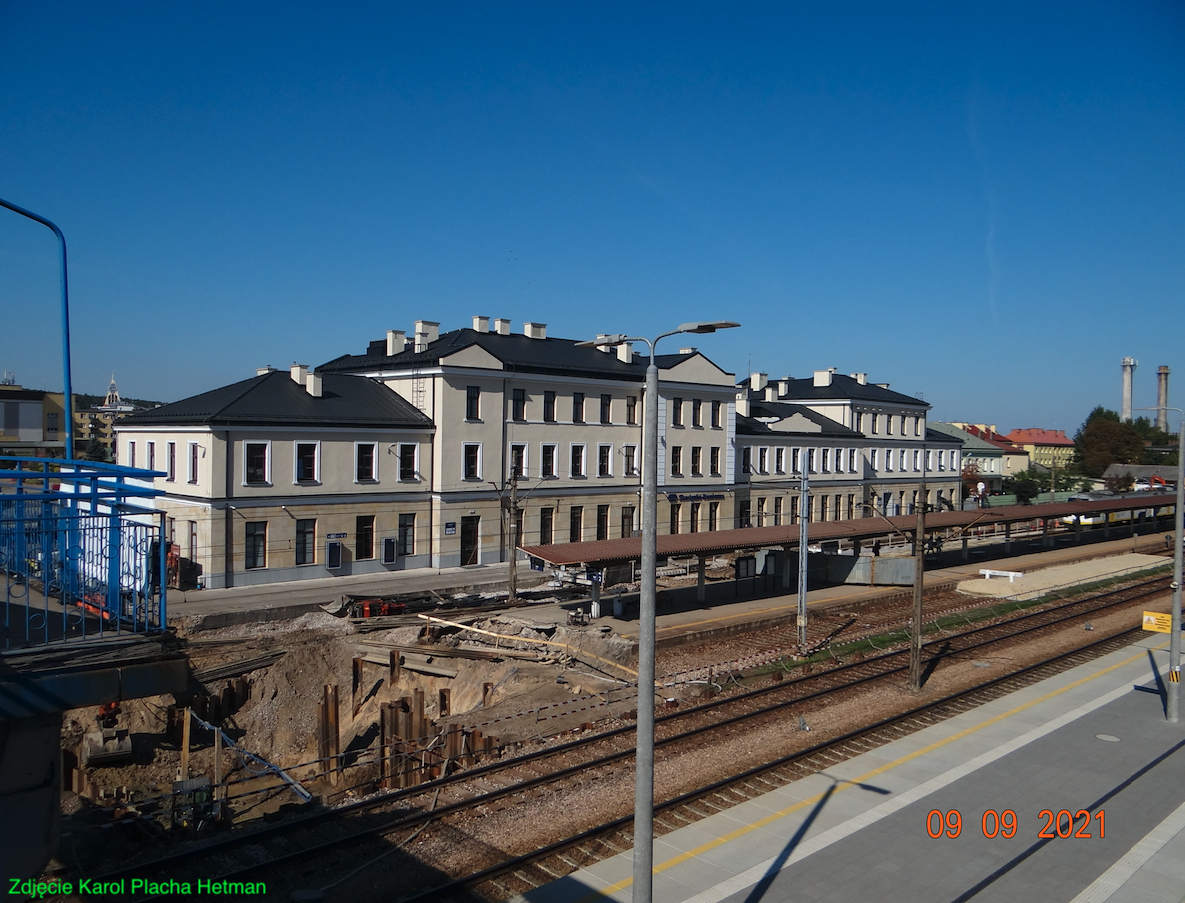Skarżysko Kamienna 2021-09-16
Skarżysko Kamienna Railway Station.
Geographic coordinates: 51.116N 20.882E. Elevation 231 m. Address: Aleja Niepodległości 90, Skarżysko-Kamienna 26-110.
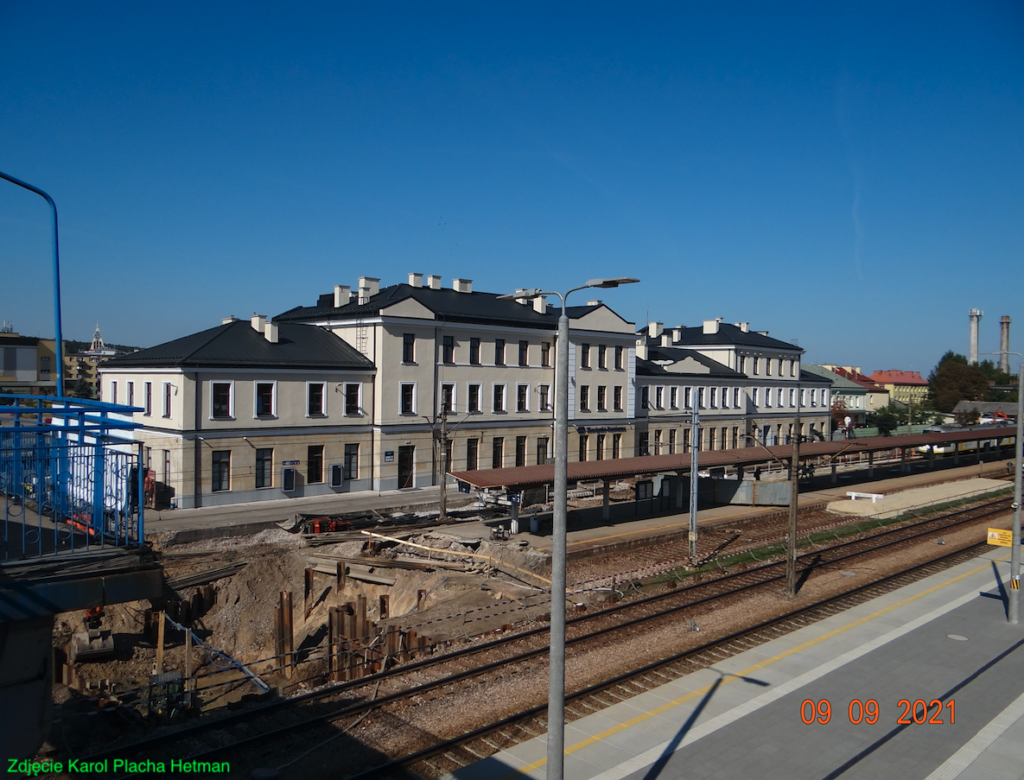
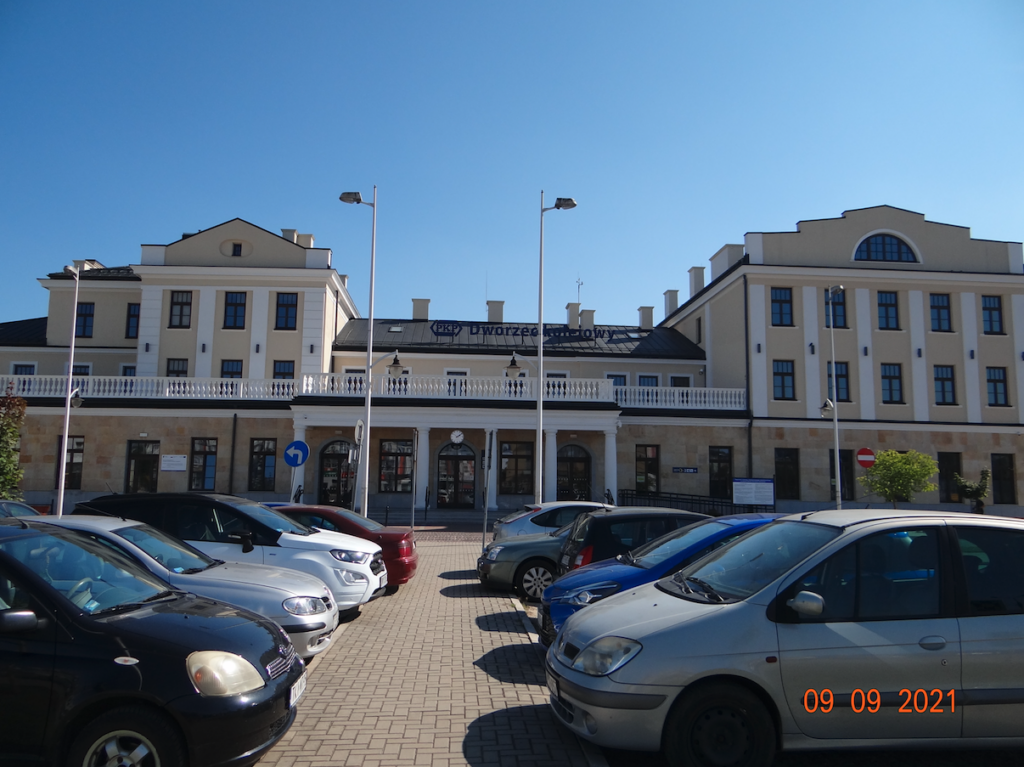
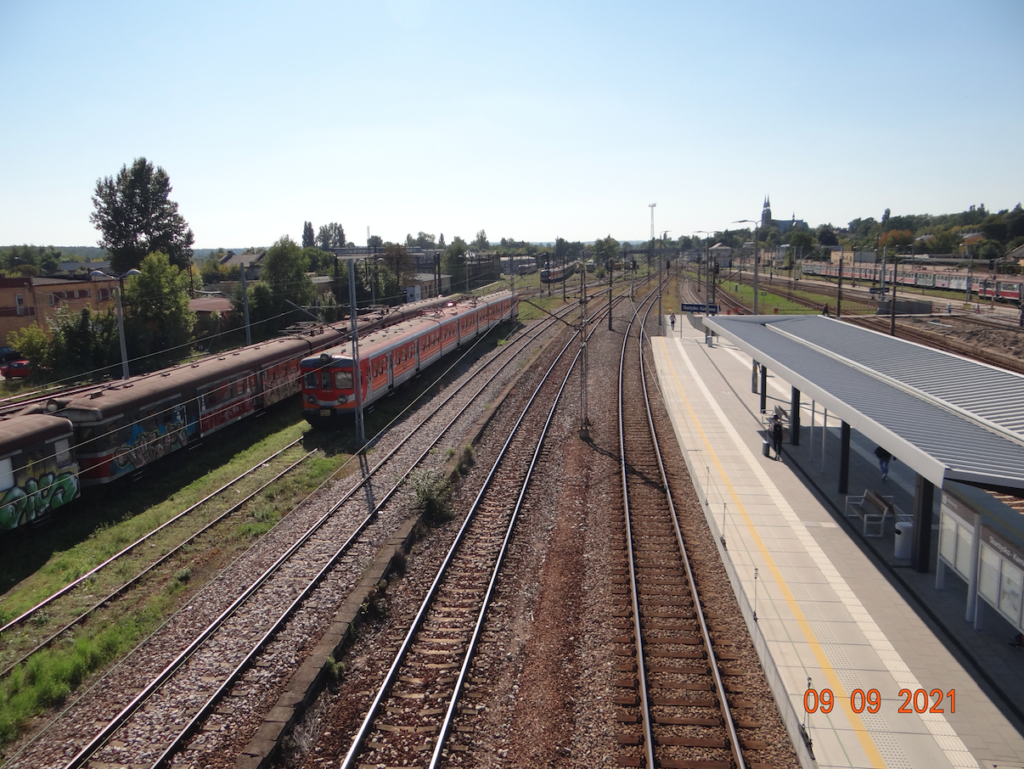

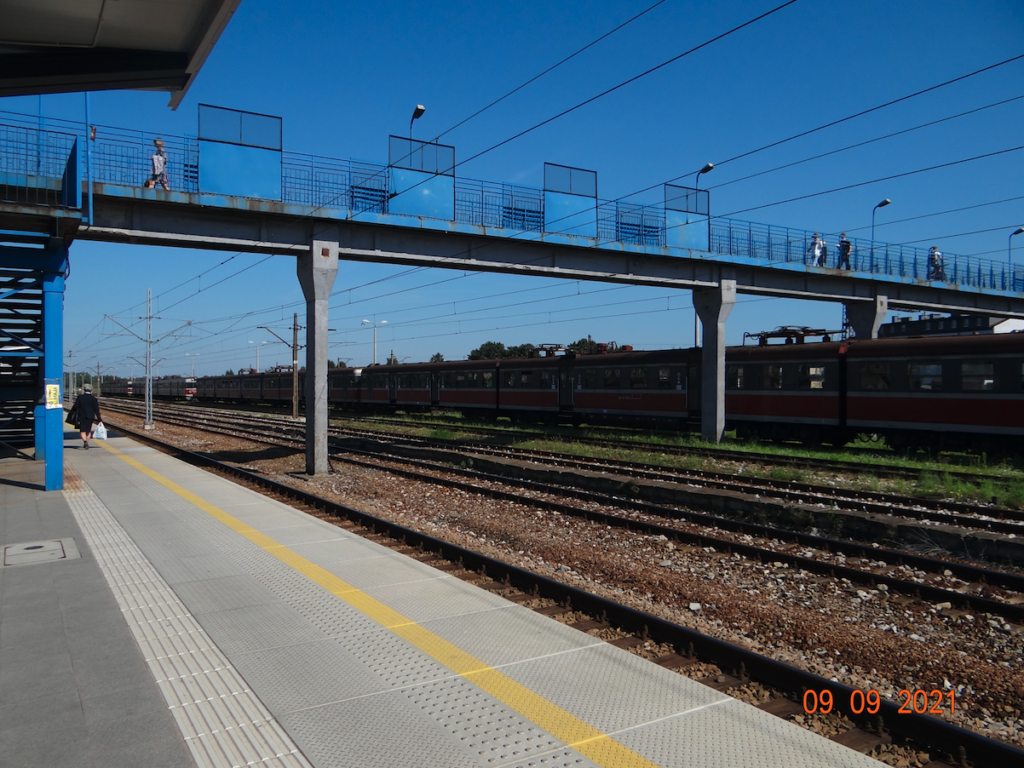
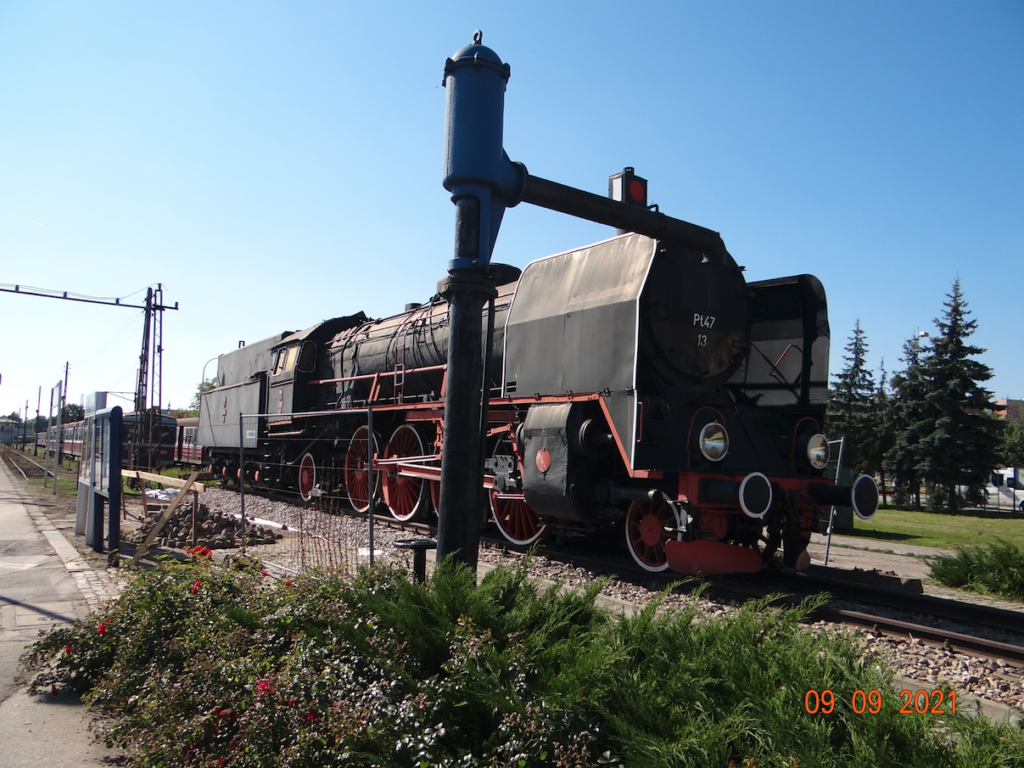
The town of Skarżysko Kamienna lies within the Old Polish Industrial Region. Iron ore mines and the first ironworks were located here as early as the 15th century. The town is situated on the Kamienna River and its tributaries, the Kamionka, Bernatka, and Oleśnica, on the border of the Świętokrzyskie Forest. Skarżysko Kamienna lies in the historic Lesser Poland region, in the former Sandomierz region. The town is relatively young, with its development dating back to the second half of the 19th century. The town was granted town rights on January 1, 1923.
In 1884, a railway line was built through this area. The section between the Radom and Tunel stations was part of the Iwanogrodzko-Dąbrowa Railway. The line ran, among other routes, through Szydłowiec, Suchedniów, and Kielce. The Ivangorod-Dąbrowa Railway (Russian: Ивангородо-Домбровская железная дорога, Ivangorod-Dombrovskaya železnaya doroga), also known as the Ivangorod-Dąbrowa Railway. The route currently connects the Dęblin and Dąbrowa Górnicza stations. The line was built between 1883 and 1885 and had a length of 462 km. It was constructed as a broad-gauge railway.
It should be remembered, however, that the Russians deliberately did not develop railway routes in the Kingdom of Poland to hinder potential enemy military operations. This, however, resulted in economic underdevelopment. A minor breakthrough in the efforts to launch a railway came in April 1875, when St. Petersburg issued a permit for the construction of a route from Ivangorod (Dęblin) to Dąbrowa (Dąbrowa Górnicza). When Poland regained independence in 1918, the route was converted to standard gauge.
In 1884, the route was laid near the village of Bzin (Russian: Бзин). The station was named Bzin (Russian: Бзин) after this village. This name was used from 1885 to 1897, until the nationalization of the railways in Russia. The name was then changed to Skarżysko (Polish: Skarzysko). This name remained in use until 1918. When Poland regained independence, the name was changed to Skarżysko, and in 1938, the current name Skarżysko Kamienna was adopted.
As soon as 1885, further branches of the route were established from the Bzin station, the station became a junction. First, the branch line ran towards Ostrowiec Świętokrzyski, where the railway station opened on January 15, 1885. Then, the branch line ran towards Końskie, where the railway station was also completed in 1885. Thus, the station became an important railway junction in the Kingdom of Poland, under Russian rule. Soon, the “Kamienna” Iron Foundry and Enamel Mill were established near the junction. Subsequently, further factories were established. In 1897, a modern steelworks was opened. Most of the factories were related to the metal industry. In 1924, the State Ammunition Factory was established.
The station in Skarżysko Kamienna itself grew significantly, employing nearly 1,000 people by the end of World War II. The station housed a large locomotive shed, a water tower, four water cranes, rolling stock repair shops with a forge and mechanical workshop, a maintenance facility, and more.
On September 1, 1939, German troops invaded Poland. In the first week, the industrial plants and railway station in Skarżysko Kamienna were heavily bombed. The locomotive shed was completely destroyed, and the station was 50% destroyed. Many locomotives, railcars, and passenger and freight cars were destroyed.
On September 8, 1939, the German occupiers entered Skarżysko Kamienna. German soldiers proudly photographed themselves against the backdrop of ruins and destroyed rolling stock. The armaments factory was taken over by the private arms company “Hasag,” which exploited Polish citizens as slave labor. The prisoner-workers were held in three large camps. The dead and slain were burned in a makeshift crematorium on the factory shooting range. It is estimated that 35,000 people had been murdered by July 1944. In August 1944, the Germans evacuated. On January 16, 1945, Skarżysko-Kamienna was occupied by soldiers of the 6th Army and the 3rd Guards Tank Army of the 1st Ukrainian Front.
The railway junction was quickly restored to full operation and continued to be expanded, as it played a crucial role in Poland’s post-war transportation system. Trains were serviced by newly built Polish steam locomotives, as well as locomotives acquired from abroad.
The Skarżysko Kamienna junction was electrified in 1969. Due to a lack of funding, the section of route No. 25 Skarżysko Kamienna – Tomaszów Mazowiecki was not electrified. To this day (2021), plans to electrify this route are still being revived from time to time. It is undoubtedly the lack of overhead contact lines that caused the last passenger train to run along this route on July 31, 2009, as a cost-cutting measure. The train was pulled by an SP42 diesel locomotive.
For several years, two retired ET21 electric locomotives stood at the station, serving as a heating source.
During the heyday of railways in Poland, the station had six signal boxes: SKA, SKB, SKC, SKD, SKE, SY, and SY2. Currently, four are in operation, but there are plans to replace them with a single computerized one.
The freight station had two marshalling yards, known as “Warszawska” and “Dęblińska.” Currently, only one hump is in use. The marshalling yard was modernized between 1986 and 1988 and automated.
For many years, the town of Skarżysko Kamienna has been expanding. Housing estates were built in the northern part of the town. The southeastern part of the town has been developed with single-family housing developments. Naturally, the town has been divided into two parts by the tracks. Communication between the two parts is difficult. Residents primarily use the footbridge at the station. Cars pass via the Piłsudskiego Avenue viaduct, which is located at the southwestern end of the station. Or from the north, a very long detour via the railway crossing at the Lipowe Pole train station (Route No. 8), or even further along Mikołaja Kopernika Street (Route No. 8) and then 1 Maja Street (Route No. 25). Plans are underway to build a pedestrian and vehicle tunnel near the station. However, the tunnel’s construction cost is estimated at approximately PLN 50 million. The proposed completion date is 2025.
The station building in Skarżysko Kamienna.
The station building was built in 1885 and, apart from periodic renovations, remained unchanged until the Great War. In 1916, the building was burned down by retreating Russian soldiers. It was rebuilt between 1918 and 1920, remaining in its original form until World War II.
During World War II, the station was 50% destroyed by German air raids. After the war, it was rebuilt between 1945 and 1947. Every few years, the station underwent surface renovations, including painting and repairing worn doors and windows.
In the 1950s, loudspeakers were installed at the station for passenger information. In the 1980s, an information system using “Pragotron” pallet displays was introduced. Currently (2021), the station features electronic railway information screens.
In June 2019, a major renovation of the station and its immediate surroundings began. The station was among the first ten stations in Poland selected for renovation by PKP S.A., with plans to renovate 200 stations and train stops. Funding for the renovation came from the Eastern Poland Operational Program and PKP’s own funds. The investment cost PLN 32 million.
On August 16, 2021 (Monday), the station officially opened after renovation. The facility is comfortable, safe, easily accessible, modern, and elegant. The building’s façade was renovated. The stone plinth was restored, and the sandstone cladding up to the first floor was cleaned and preserved. The colonnade in front of the main entrance to the station hall and the balustrades at first-floor level have also been restored to their former glory. The plasterwork on the façade was re-done in imitation of the historical ones. The window and door joinery was replaced, and lighting was installed. The signs “Dworzec Kolejowy” (Railway Station) and “Skarżysko-Kamienna” (Skarżysko-Kamienna) are illuminated, as is the clock just above the main entrance to the building from the city side. The interior has been renovated. All installations and plasterwork have been replaced. The wall cladding is made of limestone, the windows of the commercial premises are glazed, and the floors are covered with gray granite slabs. The interior now boasts a completely new look. A particularly striking feature is the station’s representative hall, connected to the waiting room, which occupies 350 square meters on the ground floor. Adjacent to the hall are ticket offices, restrooms, commercial spaces for rent, and a disabled elevator. The ticket offices have lowered desks to facilitate access for wheelchair users. A new feature is the installation of a rainwater recovery system. Rainwater is collected in a special underground tank and, after filtering, used to flush toilets. To optimize electricity, heat, and water consumption, a BMS (Building Management System) has also been installed to control the operation of installations and devices throughout the facility. The entire building has a usable area of 4,400 square meters.
Platforms in Skarżysko Kamienna.
The station has three platforms. Platform 1 is single-sided and located directly next to the station building. Its height is 0.30 m and length is 245 m. Access to Platform 1 is possible from the station building and directly from the street. Previously, Platform 1A, an extension of Platform 1, was no longer used. Platform 2 is an island platform with a shelter. The shelter is 160 m long, has an asphalt surface and benches for passengers. It is 0.30 m high and 400 m long. Platform 3 is also an island platform and was thoroughly renovated in 2020. It was raised (0.60 m) and received a new surface and shelter. The new shelter is 160 meters long. Platforms 1 and 2 will undergo the same renovation.
Currently (2021), the station is undergoing a major overhaul of the platforms and tracks. Therefore: Platform 1 is not in use. Platform 2 only has tracks towards Radom, and trains start and end at this platform. Platform 2 is a through platform, and all long-distance trains stop here.
Access to Platforms 2 and 3 is via a pedestrian bridge and level crossings, reserved for disabled persons and railway employees, and during the current renovation (2021) also for other passengers and residents. Due to the renovation, the bridge is temporarily shortened and begins only above Platform 3. The bridge will be renovated, and access ramps will be built for cyclists, who use this crossing in large numbers. However, currently (2021), cyclists must carry their bikes up the stairs. In Skarżysko Kamienna, there was no tunnel under the platforms.
A parking lot was built opposite the station, on the other side of the railway tracks, on Towarowa Street.
PKP Skarżysko Kamienna currently operates.
According to PKP classification, the station is classified as a regional station. In 2018, the station served approximately 2,500 passengers daily. The passenger section of the station is located in the central part of the city, between the Przydworcowe and Dolna Kamienna housing estates, while the freight section is located in the northeastern part, near the border with Skarżysko Kościelne. The station has four equally sized stations: one at the passenger station, two northbound, and one eastbound.
Two railway lines of national importance run through Skarżysko Kamienna: railway line No. 8 Warszawa Zachodnia – Kraków Główny and railway line No. 25 Łódź Kaliska – Dębica. The junction is largely electrified, with the exception of the Skarżysko Kamienna – Tomaszów Mazowiecki section.
Currently (2021), only part of the locomotive shed is operational. The western section of the shed is in disrepair. Only some of the walls remain, and they are home to self-seeded trees. A new PKP Cargo locomotive shed is operational near the northern freight station. A coal depot also operates, serving individual residents.
Written by Karol Placha Hetman
